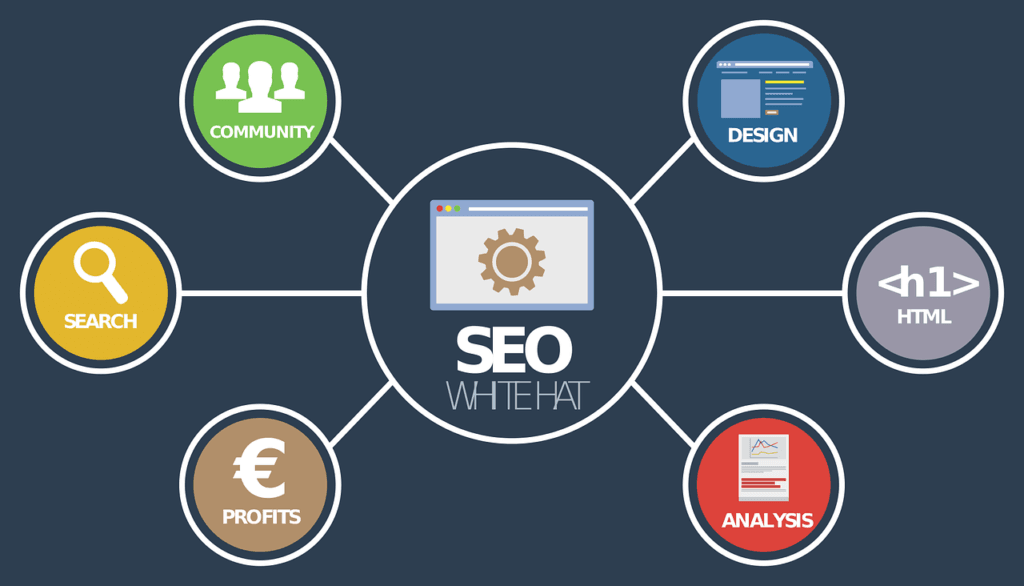(This Article has been revised, edited and added to, by Poulomi Chakraborty.)
- Understanding the SEO Landscape
- Crafting an SEO Strategy that Works
- Understanding the Competitive Landscape
- Aligning SEO with User Intent
- Leveraging Data for Content Optimization
- Building Thought Leadership through Strategic Content
- Prioritizing Technical Excellence
- Embracing Local SEO for Community Engagement
- Continuous Learning and Adaptation
- Keyword Research
- Content Strategy
- Technical SEO
- Setting the Stage for Long-term Success
- Advanced SEO Techniques for Banking Websites
- Measuring and Optimizing SEO Success
- Establishing a Comprehensive SEO Dashboard
- Advanced User Behavior Analysis for SEO Insights
- SEO Performance Benchmarking Against Competitors
- Integrating SEO with Broader Marketing Objectives
- Predictive Analytics for Future-Proofing SEO Strategy
- Cultivating a Culture of Continuous SEO Learning
- Setting Up SEO Metrics
- SEO Tools
- Continuous Optimization
- Learning from the Competitors
- A Strategic Approach to SEO Mastery
- Key Takeaways
- Unveiling the Opportunities
- Adapting to the Evolving Landscape
- The Road Ahead
- Embracing SEO as a Continuous Journey
- Building a Strong Foundation with Quality Content
- Leveraging Technology for Enhanced SEO Performance
- Prioritizing User Experience and Technical Excellence
- Crafting a Legacy of Digital Excellence
- Conclusion
In the digital sphere where every business is vying for attention, establishing a strong online presence has become a necessity rather than a choice. The banking sector, which stands as a pillar of economic progression, is no exception to this rule. The paradigm has dramatically shifted from walk-ins to log-ins, urging banking institutions to focus their efforts on improving online visibility through SEO.
But before we navigate this intricate pathway, let’s establish a clear understanding of what the banking sector should aim for while enhancing its online presence. The primary goal is to offer value, not just in terms of services but also information. An SEO optimized website should foster a user-friendly experience, characterized by high-speed loading time, easy navigability, and accessibility. It should be a platform where users can find not just services, but valuable insights, guidance, and support in their financial journey.
As we stand at the inception of our journey to unlock the secrets to sky-high rankings for your banking website, we promise a pathway characterized by learning, insights, and actionable strategies. The road ahead is filled with potentials to not just enhance your online presence but to establish a platform that stands tall in the digital space, offering value, trust, and engagement.
Understanding the SEO Landscape

In the dynamic world of digital marketing, understanding the SEO landscape is akin to mastering the art of navigating through a terrain that is constantly changing. For banking websites, this understanding not only paves the way to higher rankings but also helps in carving a niche in the competitive market space. Let us embark on a journey through this landscape, exploring its nuances and identifying potential pathways to success.
Current State of SEO in the Banking Sector
In the recent years, we have witnessed a sea change in the way banking websites approach SEO. Initially perceived as just a technical tool to enhance website visibility, SEO has now evolved to become a comprehensive strategy incorporating a myriad of elements including content creation, user experience, and technical optimization.
Industry Leaders and Their Strategies
Looking at industry leaders, it is evident that a multi-faceted approach to SEO is what sets them apart. Top banking institutions prioritize creating quality content that addresses the pain points of their target audience while also focusing on technical SEO aspects like site speed, mobile optimization, and secure connections.
For instance, many have embraced the concept of topical authority, building a robust library of content that covers a range of financial topics in-depth, thus establishing themselves as authorities in the financial space. A noteworthy strategy adopted is the focus on long-tail keywords, which not only helps in ranking higher but also in addressing specific queries of the users, thereby enhancing user satisfaction.
Case Studies: Success Stories
To comprehend the depth of successful SEO strategies, it is worthwhile to delve into a few case studies. For instance, a notable banking website managed to skyrocket its organic traffic by 200% in a year by leveraging a content strategy rooted in extensive keyword research and competitor analysis. The institution focused on creating comprehensive guides on financial topics, enriched with keywords strategically placed to cater to the user intent, thus seeing a massive spike in their rankings.
The Dynamic Nature of SEO
Understanding SEO is about keeping pace with its dynamic nature. Search engine algorithms are ever-changing, and adapting to these changes is vital.
Google’s Algorithm Updates: A Retrospective
Over the years, Google, the most popular search engine, has rolled out numerous updates to its algorithm. These updates, aimed at providing users with the most relevant and high-quality content, have significantly impacted the SEO strategies of banking websites. From focusing on mobile optimization to prioritizing user experience, these updates have urged websites to evolve continuously.
A key highlight was the introduction of the E-A-T (Expertise, Authoritativeness, Trustworthiness) principle, which urged banking websites to focus on showcasing their expertise through well-researched and authoritative content, thereby building trust with their audience.
Upcoming SEO Trends and Their Potential Impact
As we stand at the cusp of further developments, it is essential to keep an eye on the upcoming SEO trends. Voice search optimization is gradually gaining traction, with a growing number of users relying on voice assistants for search queries. For banking websites, this could mean optimizing content for conversational queries, thus offering responses that are more natural and user-friendly.
Another significant trend is the emphasis on Core Web Vitals, a set of metrics introduced by Google to measure the user experience offered by a website. Focusing on these metrics can aid in enhancing the user experience, which is crucial for banking websites to retain their clientele and attract new users.
Crafting an SEO Strategy that Works

As we delve deeper, it’s crucial to understand that for startups, especially in the banking sector, the stakes are inherently different and often higher. The digital landscape is not just a battlefield for visibility but also a space to establish credibility, trust, and long-term customer relationships. The following sections outline a strategic, comprehensive SEO approach that goes beyond conventional wisdom, providing unique, actionable insights tailored for startup founders.
Understanding the Competitive Landscape
Before embarking on any SEO journey, it’s essential to have a granular understanding of the competitive landscape. This involves more than just knowing who your competitors are; it requires a deep dive into their strategies, their strengths and weaknesses, and the niches they occupy. Use competitive analysis tools to uncover the keywords they rank for, the structure of their content, and their backlink profiles. This information serves as a foundation upon which to build a differentiated SEO strategy that speaks directly to gaps in the market and opportunities for innovation.
Aligning SEO with User Intent
At the heart of a successful SEO strategy lies the alignment with user intent. For banking startups, this means understanding the financial needs, concerns, and questions that potential customers have at different stages of their journey. From informational queries about financial planning to transactional searches for specific banking services, tailoring your content to meet these needs can significantly enhance your SEO effectiveness. This approach not only improves rankings but also positions your startup as a helpful, authoritative resource in the financial landscape.
Leveraging Data for Content Optimization
In the age of data abundance, leveraging analytics and user feedback for content optimization is a non-negotiable. Use tools to analyze user behavior on your site, identifying which pages capture attention and which ones have high bounce rates. Such insights allow for iterative improvements, ensuring that content not only ranks well but also engages and converts. Additionally, consider implementing schema markup to help search engines understand the context of your content, thereby improving the chances of featuring in rich snippets and voice search results.
Building Thought Leadership through Strategic Content
For startups in the banking sector, establishing thought leadership is a powerful way to differentiate and build trust. This involves creating content that goes beyond the basics, offering in-depth analysis, forward-thinking perspectives, and actionable advice on financial matters. Collaborate with industry experts, conduct original research, and tap into emerging trends to produce content that sets your startup apart. This strategy not only bolsters SEO through engagement and backlinks but also solidifies your brand’s authority in the financial space.
Prioritizing Technical Excellence
Technical SEO remains a cornerstone of any successful strategy. For startups, ensuring that your site is fast, secure, and mobile-friendly is just the beginning. Advanced strategies involve leveraging the latest in web technologies such as AMP (Accelerated Mobile Pages) and PWA (Progressive Web Apps) to enhance user experience. Furthermore, conduct regular site audits to identify and rectify any technical issues that could impede search engine crawling and indexing, such as broken links, duplicate content, or improper redirects.
Embracing Local SEO for Community Engagement
For banking startups with a physical presence, local SEO can be a game-changer. It’s about being visible and accessible to your community when they search for banking services “near me.” Ensure your startup is listed accurately across all relevant directories, and focus on garnering positive reviews from local customers. Create content that addresses local financial issues or events, establishing your brand as an engaged and knowledgeable community member.
Continuous Learning and Adaptation
The SEO landscape is perpetually evolving, with new trends, tools, and techniques emerging regularly. For startups, maintaining a culture of continuous learning and adaptation is vital. Encourage your team to stay informed about SEO best practices and algorithm updates. Experiment with new strategies, measure the results, and refine your approach based on data-driven insights. Remember, SEO is not a set-it-and-forget-it task but a continuous cycle of improvement and optimization.
Keyword Research
In the vast landscape of SEO, keywords serve as the landmarks guiding users to your banking website. Understanding the art and science of keyword research is therefore pivotal in crafting an SEO strategy that stands tall in the competitive market.
The Importance of Keyword Research
Keywords are not just phrases that people enter in search engines; they are an insight into the users’ needs and preferences. Banking websites can leverage keyword research to understand what potential clients are looking for, thereby offering solutions that are both relevant and timely.
Moreover, keywords hold the power to enhance the visibility of your website, thereby drawing organic traffic that is more likely to convert. They serve as the foundation upon which the edifice of SEO is built, paving the path to a website that resonates with the target audience.
Tools and Techniques for Effective Keyword Research
As we delve into the world of keyword research, a variety of tools and techniques come to our aid. Tools like Google Keyword Planner and SEMrush offer invaluable insights into the trending keywords in the banking sector, their search volumes, and competition.
While leveraging these tools, it is essential to focus on long-tail keywords, which are not only less competitive but also cater to specific user queries, thereby offering a higher conversion rate. Furthermore, analyzing the keywords used by competitors can offer a competitive edge, helping to carve out a niche in the digital space.
Content Strategy
Once the keywords have been identified, the next step is to weave them into a content strategy that is both engaging and informative. The content strategy stands as a pillar supporting the SEO structure, dictating the user engagement and satisfaction.
The Role of Content in SEO
In the SEO landscape, content is the king. It is through content that a website communicates with its users, offering them insights, solutions, and a pathway to the services offered. For banking websites, content serves as a platform where users can find reliable information on financial matters, gaining trust and fostering a relationship that goes beyond transactions.
Moreover, content holds the power to enhance the website’s authority in the digital space, by offering well-researched and comprehensive information on financial topics. It is therefore essential to craft content that not only leverages the right keywords but also offers value to the users.
Developing a Content Strategy that Resonates with Your Audience
As we focus on developing a content strategy that resonates, understanding the audience becomes pivotal. Banking websites should strive to create content that addresses the unique needs and pain points of their clientele, offering solutions that are both innovative and reliable.
An effective strategy could encompass a variety of content formats, including blog posts, infographics, and webinars, offering users a rich and diverse source of information. Moreover, integrating storytelling into the content strategy can enhance engagement, by offering users a narrative that is both compelling and relatable.
Technical SEO
Behind the scenes of a successful SEO strategy lies the powerhouse of technical SEO. It encompasses the elements that enhance the website’s functionality, ensuring a smooth and satisfying user experience.
Technical SEO refers to the optimization of the website structure, ensuring that the search engines can crawl and index the website efficiently. It encompasses a range of elements including site speed, mobile optimization, and secure connections, all of which play a pivotal role in determining the website’s ranking in search engine results. For banking websites, focusing on technical SEO is not just about enhancing rankings, but also about offering a platform that is secure and reliable, fostering trust with the users.
Key Technical SEO Aspects to Focus On
As we delve deeper into technical SEO, certain aspects emerge as key focus areas. Ensuring a fast-loading website, optimizing for mobile devices to cater to the increasing number of mobile users, and focusing on secure connections to protect sensitive user data are pivotal. Moreover, creating a well-structured website with a clear hierarchy and easy navigability can enhance the user experience, encouraging users to explore further and engage more with the website.
Setting the Stage for Long-term Success
In the competitive, fast-paced world of digital banking, SEO is a critical lever for visibility, credibility, and customer acquisition. By expanding on conventional SEO strategies with a focus on competitive analysis, user intent, content optimization, thought leadership, technical excellence, local engagement, and continuous learning, startups can carve out a unique space in the digital landscape. Implementing these strategic and actionable insights will not only enhance your SEO performance but also set the stage for long-term success in the banking sector.
Advanced SEO Techniques for Banking Websites

The quest for higher rankings requires banking startups to not only master the basics of SEO but also to delve into advanced techniques that can set them apart in a crowded digital marketplace. This section explores cutting-edge strategies and innovative approaches that can elevate your banking website’s SEO performance, ensuring you stay ahead of the curve and effectively reach your target audience.
Link Building
Beyond basic link-building practices, there are advanced strategies that can further enhance your website’s authority and SEO performance. Strategic partnerships with fintech influencers, guest appearances on financial podcasts, and collaborations on industry research reports can generate high-quality backlinks and elevate your brand’s authority. Additionally, leveraging unlinked brand mentions by reaching out to publishers and requesting the addition of a link can be an effective tactic to increase your site’s backlink profile.
Why is Link Building Crucial?
At the heart of link building is the concept of endorsement. When a reputable website links to your content, it essentially vouches for your credibility, portraying your website as a reliable source of information. Furthermore, quality backlinks can enhance the visibility of your website in search engine results, helping in attracting a larger audience.
Strategies for Effective Link Building
An effective link building strategy should focus on earning links from authoritative and relevant websites. Initiatives such as guest blogging, creating high-quality content that others naturally want to link to, and forging partnerships with reputable institutions in the financial sector can be fruitful. Moreover, leveraging the power of social media to promote your content can also aid in link building, encouraging users to share your content, and thereby increasing its reach and potential to earn links.
Local SEO
With the increasing emphasis on personalized search results, local SEO has emerged as a critical focus area. It helps in reaching out to local customers, offering them solutions that are nearby and accessible.
The Essence of Local SEO
Local SEO is about optimizing your banking website to rank higher for a local audience. It involves a range of strategies including optimizing your Google My Business listing, garnering positive reviews, and creating content that resonates with the local audience. For banking institutions with physical branches, local SEO is a potent tool to drive foot traffic to your locations, by attracting local customers through your online presence.
Tips for Boosting Local SEO
To boost your local SEO, focus on optimizing your website for location-based keywords, and ensure that your NAP (Name, Address, Phone number) information is consistent across all platforms. Encourage satisfied customers to leave positive reviews on Google and other review platforms to enhance your credibility in the local market.
Mobile SEO
With a significant chunk of users accessing websites through mobile devices, mobile SEO has become a non-negotiable aspect of SEO strategy. Mobile SEO is about optimizing your website to offer an impeccable user experience on mobile devices. It encompasses a range of strategies including responsive design, fast loading times, and easy navigability to ensure a smooth user journey on mobile platforms.
For banking websites aiming to enhance their mobile SEO, focusing on creating a responsive design that adjusts seamlessly to different screen sizes should be a priority. Moreover, optimizing images and scripts to ensure fast loading times, and integrating easy-to-use navigation menus can aid in offering a satisfying mobile user experience.
Voice Search Optimization
With the advent of digital assistants, voice search has been on a steady rise, opening up a new frontier in SEO. Voice search optimization is pivotal in catering to a growing segment of users who prefer using voice commands to conduct search queries. It involves optimizing your content to align with the conversational tone and natural language used in voice searches, to ensure that your website ranks higher in voice search results.
Voice Search Optimization Tips
To optimize for voice search, focus on incorporating long-tail keywords that mimic natural speech patterns. Creating FAQ sections that answer common questions concisely can also be a great strategy, helping in ranking for voice searches by providing direct answers to user queries.
Integrating AI and Machine Learning for SEO Optimization
With the advent of artificial intelligence (AI) and machine learning, SEO strategies have evolved to become more dynamic and intelligent. AI tools can analyze large datasets to uncover patterns and insights about user behavior, search intent, and content performance. By leveraging these technologies, banking startups can refine their SEO strategies, optimizing content and user experience in real-time based on data-driven insights. For instance, AI-powered chatbots can improve user engagement, providing instant answers to financial queries and thereby increasing the time spent on your site—a positive signal for search engines.
Harnessing the Power of Video Content
In the digital age, video content has emerged as a powerful medium for engaging audiences and enhancing SEO. For banking startups, creating informative and engaging video content can be a strategic move to capture the attention of potential customers. Videos explaining complex financial concepts, customer testimonials, and behind-the-scenes looks at your banking services can significantly increase user engagement and time spent on your site. Additionally, videos can be optimized for search engines through accurate transcripts, engaging titles, and descriptions filled with targeted keywords, further boosting your SEO efforts.
Implementing Structured Data to Stand Out in SERPs
Structured data markup is a crucial yet often overlooked component of advanced SEO strategies. By implementing schema markup, banking startups can help search engines better understand the content of their pages, leading to enhanced visibility in search engine results pages (SERPs) through rich snippets. For instance, marking up FAQs, financial products, or branch location information can lead to more prominent and informative displays in search results, increasing click-through rates and driving more traffic to your site.
Leveraging Social Media for SEO Synergy
While social media signals do not directly impact search rankings, the strategic use of social media can amplify your content’s reach and generate backlinks, indirectly benefiting SEO. By creating shareable content and actively engaging with your audience on social platforms, banking startups can increase their brand visibility and encourage natural link building. Social media can also be used to target specific groups with personalized content, driving targeted traffic back to your website.
A Proactive Approach to SEO Mastery
For banking startups, navigating the complex world of SEO requires a proactive, innovative approach. By embracing advanced techniques such as AI optimization, video content strategy, structured data implementation, and a strong focus on user experience, startups can achieve higher rankings, drive more traffic, and establish a strong online presence in the competitive banking sector. Ultimately, the key to SEO success lies in continuous learning, adaptation, and a commitment to offering value to your users—principles that will guide your banking website to sky-high rankings and beyond.

Related: Check out our free SEO suite

Measuring and Optimizing SEO Success
For startup founders in the banking sector, understanding the nuances of measuring and optimizing SEO success is paramount. The ability to accurately gauge the impact of your SEO strategies and make informed adjustments is what ultimately separates the market leaders from the followers. This section aims to deepen the strategic approach to SEO measurement and optimization, ensuring your banking website not only achieves high rankings but also sustains them over time.
Establishing a Comprehensive SEO Dashboard
Creating a comprehensive SEO dashboard is the first step towards effectively measuring and optimizing your SEO success. This dashboard should integrate data from various sources, including Google Analytics, Google Search Console, and SEO tools like SEMrush or Ahrefs, providing a holistic view of your website’s performance. Key metrics such as organic search traffic, keyword rankings, click-through rates (CTR), and backlink profiles should be monitored closely. By having all relevant data at your fingertips, you can quickly identify trends, pinpoint issues, and make data-driven decisions to enhance your SEO strategy.
Advanced User Behavior Analysis for SEO Insights
Delving deeper into user behavior analysis can uncover valuable SEO insights that traditional metrics might overlook. Tools like Hotjar or Google Analytics offer features like heatmaps, session recordings, and behavior flow analysis, which can help you understand how users interact with your website. Identifying patterns such as common drop-off points or pages with high engagement can inform both your content strategy and website design, ensuring they are optimized to meet the users’ needs and preferences. This level of analysis allows for nuanced optimizations that can significantly impact your SEO performance and user satisfaction.
SEO Performance Benchmarking Against Competitors
In the competitive banking industry, benchmarking your SEO performance against competitors can provide critical insights into your relative positioning and uncover opportunities for improvement. Analyze competitors’ keyword strategies, backlink profiles, and content marketing efforts to identify gaps in your own strategy or areas where they have gained an advantage. This competitive intelligence can guide strategic adjustments in your SEO approach, helping you to capture additional market share and improve your rankings.
Integrating SEO with Broader Marketing Objectives
SEO should not exist in isolation but be integrated with your broader marketing objectives. Align your SEO goals with your overall business goals, such as increasing customer acquisition, enhancing brand awareness, or driving product sign-ups. By ensuring your SEO strategy supports these objectives, you can create a more cohesive and effective overall marketing strategy. Regular cross-functional meetings with marketing, sales, and product teams can ensure alignment and encourage collaborative efforts to maximize the impact of your SEO initiatives.
Predictive Analytics for Future-Proofing SEO Strategy

Leveraging predictive analytics can help future-proof your SEO strategy by forecasting trends and potential changes in search behavior. Tools that utilize AI and machine learning can analyze vast amounts of data to predict which topics are likely to become more relevant, which keywords could gain in popularity, and how user behavior might evolve. By staying ahead of these trends, you can adapt your content and SEO strategy proactively, ensuring that your banking website remains competitive in the ever-changing digital landscape.
Cultivating a Culture of Continuous SEO Learning
The field of SEO is dynamic, with search algorithms, best practices, and user behaviors constantly evolving. Encouraging a culture of continuous learning within your team can ensure that your SEO strategy remains innovative and effective. Participate in SEO webinars, workshops, and conferences, and encourage your team to engage with industry blogs and forums. Regular training sessions can also help disseminate new insights and techniques across your team, fostering a shared commitment to SEO excellence.
Setting Up SEO Metrics
In the realm of SEO, setting up the right metrics is like setting up a compass, helping in navigating the path to success with clarity and precision.
Why SEO Metrics are Vital
SEO metrics are vital because they offer tangible data to gauge the performance of your SEO strategies, providing insights into what is working and what needs tweaking. For banking websites, understanding these metrics can help in crafting strategies that resonate with the audience, fostering a strong and reliable online presence.
Key SEO Metrics to Track
As we venture into the world of SEO metrics, certain parameters emerge as pivotal. Metrics such as organic traffic, bounce rate, conversion rate, and keyword rankings offer a holistic view of your SEO performance. Furthermore, tracking the page load time and user engagement metrics can provide deeper insights into the user experience, helping in fine-tuning your strategies to offer a stellar online journey to your users.
SEO Tools
In your SEO endeavor, leveraging the right tools can be akin to having a seasoned guide, offering the pathways to success with insights and data-driven recommendations. SEO tools play a crucial role in crafting a successful SEO strategy. They offer data and insights that can guide your SEO initiatives, helping in identifying opportunities and streamlining efforts to enhance the visibility and credibility of your banking website.
Must-Have SEO Tools
The SEO landscape is adorned with a plethora of tools, each offering unique functionalities. Tools like Google Analytics and Google Search Console offer a wealth of data on website performance and user behavior. Moreover, tools like SEMrush and Moz can aid in keyword research and backlink analysis, helping in crafting strategies that are both robust and data-driven.
Continuous Optimization
In the ever-evolving digital landscape, continuous optimization emerges as a mantra for success, fostering growth and adaptability.
Why Continuous Optimization is Essential
SEO is not a one-time endeavor. It is a continuous journey that requires constant tweaking and optimization to align with the changing algorithms and user preferences. For banking websites, it entails keeping abreast with the latest industry trends and consumer behavior, offering a dynamic platform that evolves with the changing times.
Strategies for Continuous Optimization
As we aim for continuous optimization, focusing on regular website audits to identify areas of improvement can be pivotal. Moreover, leveraging A/B testing to understand user preferences and optimizing content based on user feedback can aid in creating a website that is not only optimized for search engines but also resonates with the users.
Learning from the Competitors
In the competitive digital space, learning from the competitors can offer a roadmap to success, providing insights into strategies that work.
Why Analyzing Competitors is Beneficial
Analyzing competitors can offer a wealth of knowledge, helping in understanding the strategies that are yielding success in the industry. For banking websites, it can provide insights into content strategies, keyword focus, and user engagement initiatives that are resonating with the audience.
Competitive Analysis Strategies
To conduct a successful competitive analysis, focus on analyzing the backlink profiles of your competitors to understand their link-building strategies. Moreover, leveraging tools to analyze the keyword focus of competitors can offer a competitive edge, helping in identifying gaps and opportunities for growth.
A Strategic Approach to SEO Mastery
Measuring and optimizing SEO success goes beyond tracking rankings and traffic. It involves a strategic, comprehensive approach that leverages advanced analytics, competitive benchmarking, integration with broader marketing goals, and a forward-looking perspective. By establishing a robust framework for measurement and optimization, banking startups can not only achieve but also sustain high rankings, driving long-term growth and success in the competitive digital landscape. Embracing continuous learning and innovation will ensure that your SEO strategy remains at the forefront of industry best practices, solidifying your position as a leader in the banking sector.
Key Takeaways

In the world of relentless competition, financial institutions cannot afford to overlook the potential of SEO. The pathway to success involves a harmonious blend of various strategies, ranging from the foundational aspects of understanding SEO to leveraging advanced techniques like mobile and voice search optimization.
Unveiling the Opportunities
By delving deep into SEO, banking institutions can unveil a world of opportunities, reaching out to a diverse audience and offering them solutions that resonate with their needs. SEO emerges not just as a tool for visibility, but as a catalyst for building trust and fostering relationships with the customers.
Adapting to the Evolving Landscape
The SEO landscape is dynamic, necessitating a proactive approach to adapt and evolve. Financial institutions have to be nimble, constantly optimizing their strategies to align with the changing algorithms and user preferences. This journey highlighted the essence of continuous optimization, emphasizing the need for banking websites to be fluid and adaptable, to maintain a robust online presence.
The Road Ahead
As banking websites gear up to leverage the full potential of SEO, a road laden with opportunities and growth beckons.
Fostering a Culture of Learning
A pivotal lesson from this exploration is the necessity to foster a culture of learning, encouraging teams to keep abreast with the latest trends and innovations in the SEO landscape. Financial institutions can benefit immensely by investing in training and development, building a team that is equipped to navigate the ever-evolving digital landscape.
Embracing Innovations
The SEO realm is vibrant, constantly blossoming with new innovations. The road ahead for banking websites involves embracing these innovations with open arms, leveraging tools and technologies to offer a seamless online experience to the users, and carving a niche in the digital space.
Embracing SEO as a Continuous Journey
The dynamic nature of the digital landscape mandates that SEO should be perceived not as a destination but as a continuous journey. Success in SEO requires ongoing adjustments and refinements based on ever-evolving search engine algorithms, user behavior trends, and competitive landscapes. For startup founders, this means fostering a culture of agility within your organization, where the ability to quickly adapt and implement new SEO strategies becomes a key driver of online success. Regularly scheduled SEO audits and strategy reviews should be integral to your operational rhythm, ensuring that your banking website remains aligned with the best practices and latest innovations in search engine optimization.
Building a Strong Foundation with Quality Content
At the core of any successful SEO strategy lies the imperative of quality content. For banking websites, this translates into creating informative, engaging, and trustworthy content that addresses the needs and questions of your target audience. The goal is to establish your startup as a thought leader in the banking sector, offering insights and solutions that go beyond the transactional nature of banking services. Crafting content that resonates with your audience requires a deep understanding of their challenges, aspirations, and financial journeys. By prioritizing content that educates, informs, and empowers, you set the stage for building long-lasting relationships with your users, thereby enhancing both your SEO performance and your brand’s reputation.
Leveraging Technology for Enhanced SEO Performance
The integration of advanced technologies such as AI, machine learning, and predictive analytics into your SEO strategy offers a competitive edge in the crowded banking sector. These technologies can provide deep insights into search trends, user intent, and content performance, enabling data-driven decisions that propel your website to the top of search rankings. Additionally, embracing innovations in website design and user experience, such as voice search optimization, mobile responsiveness, and fast loading speeds, ensures that your banking website meets the high expectations of today’s digital users. For startup founders, staying abreast of technological advancements and integrating them into your SEO and content strategies is crucial for achieving and sustaining high rankings.
Prioritizing User Experience and Technical Excellence
A seamless, intuitive, and secure user experience is paramount for banking websites, not only from a customer service standpoint but also for SEO success. Technical excellence in website design ensures that search engines can efficiently crawl and index your site, while users enjoy a frictionless experience that encourages engagement and return visits. Aspects such as site architecture, mobile optimization, and security protocols play significant roles in both user satisfaction and search engine rankings. Investing in a robust technical foundation for your banking website is an investment in your startup’s online visibility and credibility.
Crafting a Legacy of Digital Excellence
The path to securing sky-high rankings for your banking website is paved with challenges, requiring a blend of strategic foresight, technical savvy, and content mastery. For startup founders, the journey involves a commitment to continuous improvement, a deep understanding of your audience, and a willingness to leverage technology for greater insights and impact. By embedding these principles into your SEO strategy, you not only enhance your website’s search engine performance but also build a digital legacy that resonates with users and sets your banking startup apart in the digital era. Embrace these key takeaways as your guideposts on the journey to SEO success, and chart a course for a future where your banking website stands as a beacon of trust, authority, and innovation in the online financial landscape.
Conclusion
As we conclude, it becomes evident that the world of SEO offers a fertile ground for growth and expansion for banking websites. By harnessing the potential of SEO, financial institutions can build a stronghold in the online space, reaching out to a wider audience and offering solutions that are tailored to meet the diverse needs of the consumers.
In this enriching journey, we unearthed the secrets to sky-high rankings, offering a blueprint for success in the digital landscape. As banking websites embark on this SEO journey, a world of limitless possibilities unfolds, promising growth, visibility, and a strong online presence that resonates with the audience. Banking websites stand on the cusp of a digital revolution, equipped with the insights and strategies to carve a path to success in the online realm. By embracing SEO with a strategic and informed approach, the future promises sky-high rankings, enhanced visibility, and a vibrant growth trajectory.
Read Next:
- Productivity Apps for Entrepreneurs
- Startup Funding in India – An In-Depth Guide
- How to Invest or Set up a Business in India – The Definitive Guide
- How to use Leadpages: An Explainer
- 15 Best AI Marketing Tools to Elevate Your Business Growth






















Comments are closed.